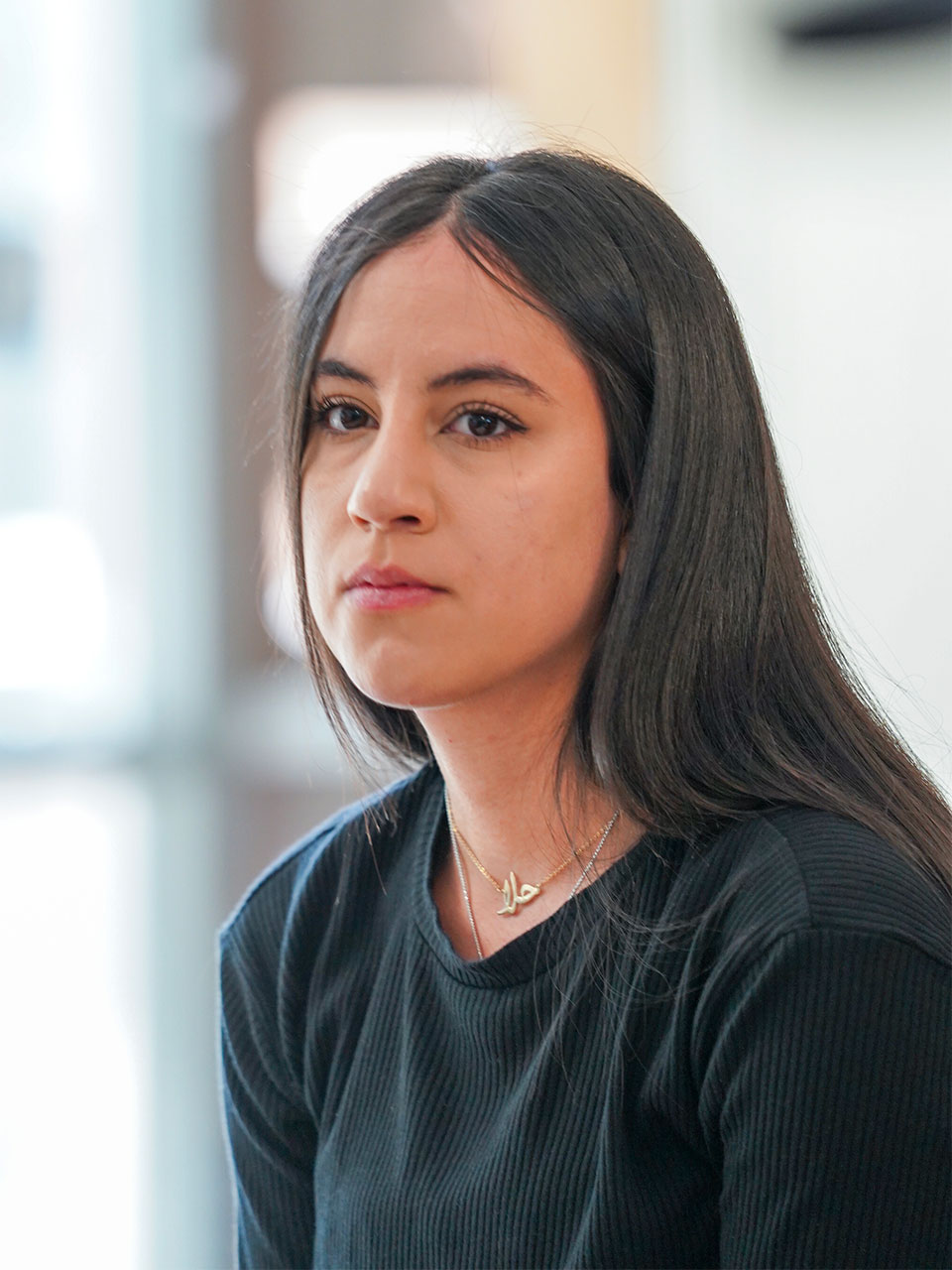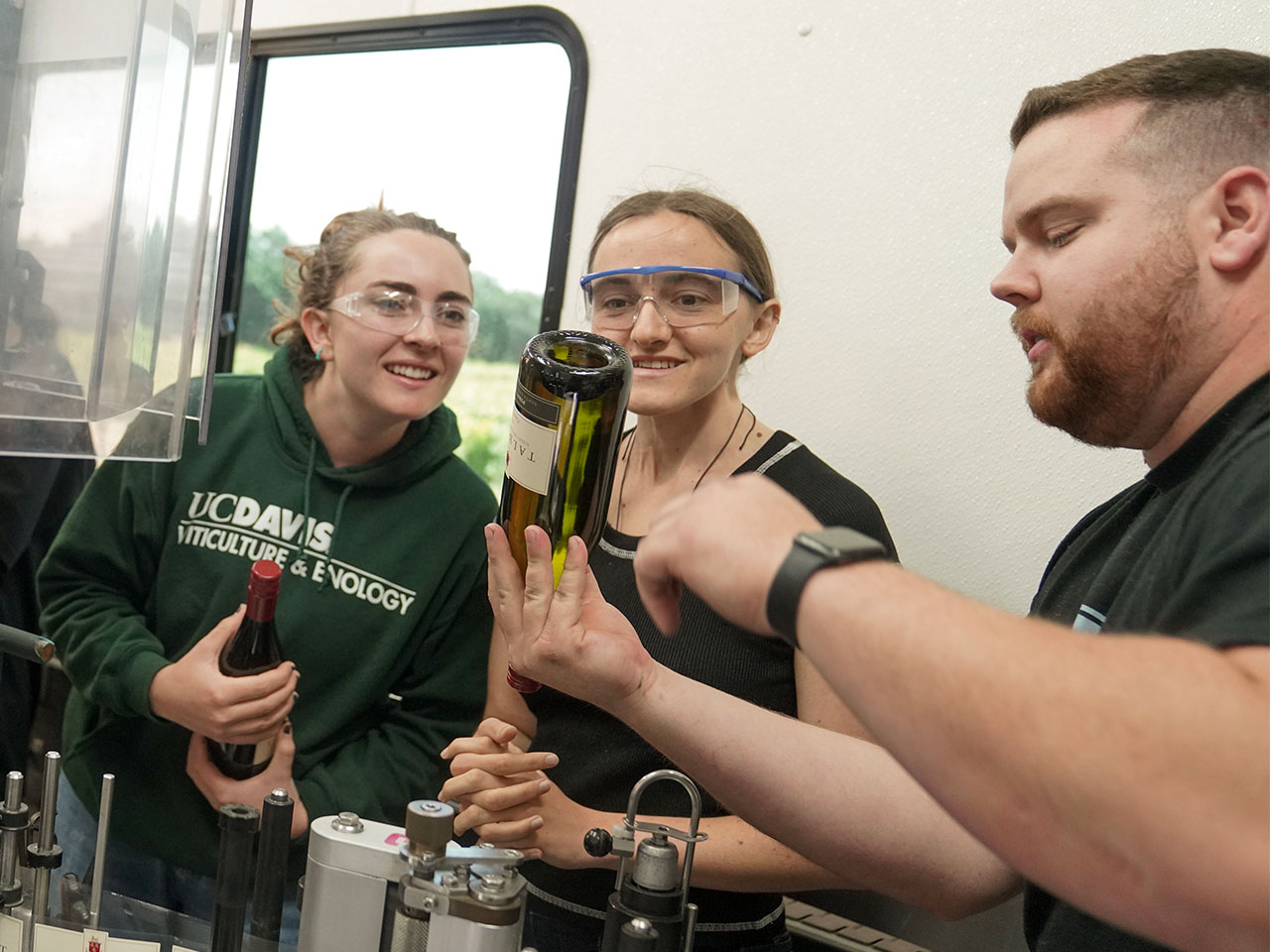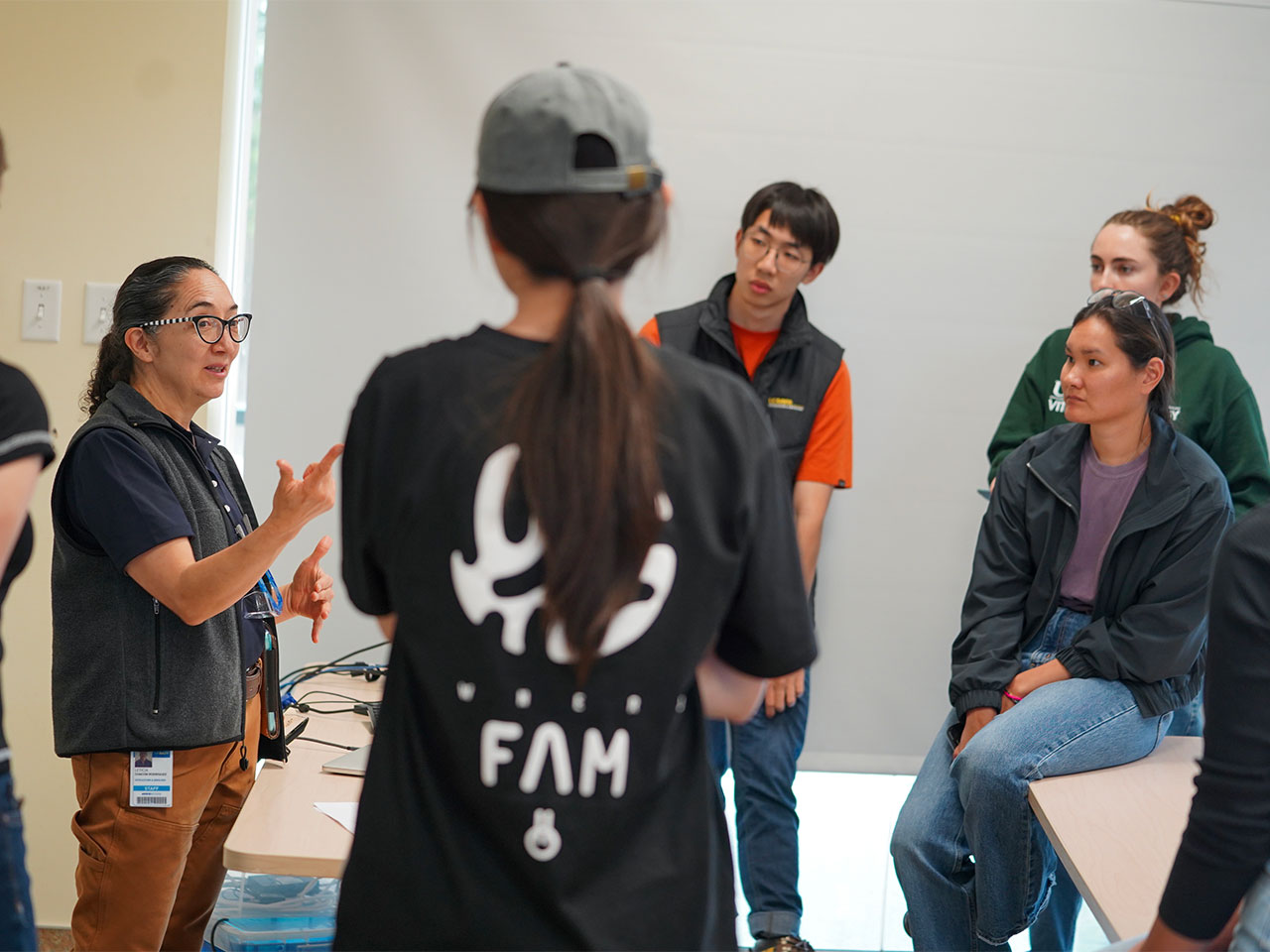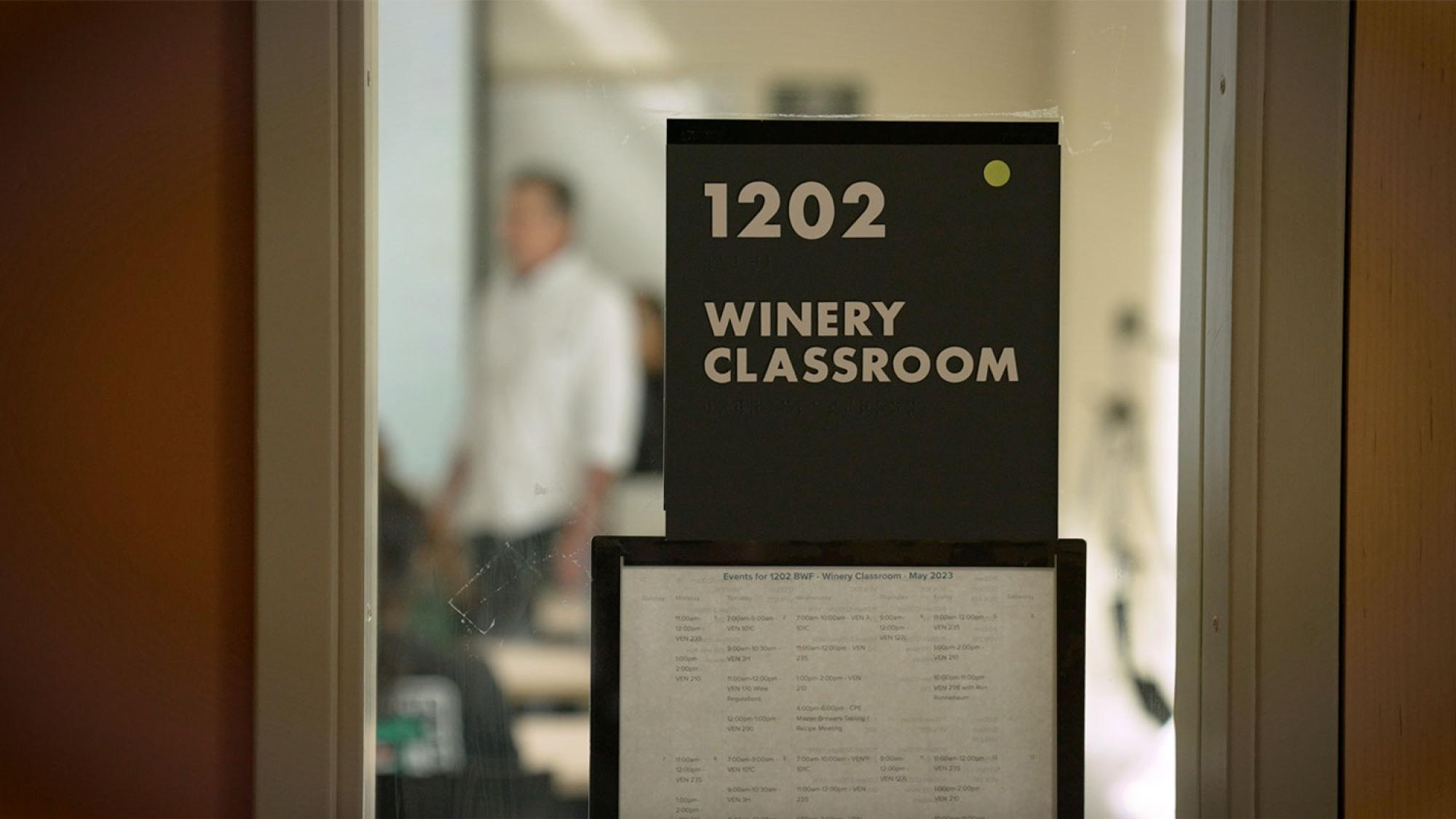Deep green wine bottles whir along in a neat row. They twist and twirl through the mechanical line as if they were practicing a perfectly timed dance. Their audience: safety-goggled college students.
Erin Halsey, who runs logistics at her father’s mobile wine bottling company, Halsey Bottling, answers the students’ questions along with two other employees.
“It's exciting to be around the next generation of winemakers,” said Robert Gilson, a manager at Halsey Bottling. “And everybody is so darn smart.”
These students are enrolled in VEN127L — “Post-Fermentation Wine Processing Lab” at UC Davis. In the course, students learn how to taste, blend, fine, age, filter and package their own wines. The students’ hands-on experience translates directly into skills needed in the wine industry.
How students are prepared for winery jobs
Wineries value hands-on experience. They want incoming employees to not only be prepared with technical knowledge, but also be able to problem-solve when things inevitably become challenging.
VEN127L was born out of wineries' desperate need for workers who are both smart and skilled. The industry needed new graduates to be able to make excellent wine and know the best ways to market it.
So this winemaking course, which was created in 2017, is now an official part of the university’s viticulture and enology curriculum. Its goal is to fill the gap that wineries are facing today.
“The idea for the course came out of focus group discussions we had with the industry about seven or eight years ago,” said David Block, Marvin Sands department chair. “We went around and asked the industry, ‘What are the strengths of our program, and where are the areas you’d like our students to have more knowledge?’”

From the focus group discussions, Block, who is also the Ernest Gallo Endowed Chair of Viticulture and Enology, discovered that student learning from vineyard through the wine fermentation process was the program’s strength. There was a gap of knowledge in what came after that.
The goal of VEN127L is to give students the opportunity to put everything they’ve learned in the program to the test — but not the kind of test students normally take in college.
“You don't have any exams or quizzes,” said Hala Hark, a fourth-year transfer student in the viticulture and enology program. “You’re purely learning, having hands-on experience, applying what you learn. And it's fun! All the microbiology and other stages of winemaking we learn in other classes, we apply here.”
The students are guided by instructors, teaching assistants, consultants and guest wine industry professionals like Halsey Bottling.
“Having real life experience along with classroom time is always really great,” said Halsey. “We're happy to be a resource for students.”

How long does it take to make wine?
While wine usually takes several years to make, UC Davis students are finishing the entire winemaking process (including labeling, packaging and marketing) in just 10 weeks.
Rather than worrying about midterms and finals, the students are focused on finishing their wine before the end of the spring quarter.
“The biggest challenge of this course is probably the timeframe that we do it in,” said one of the course’s instructors, Ben Montpetit, vice-chair and associate professor (yeast biology) of the departments of viticulture and enology, and food science and technology.
“Making wine is often a year or longer process,” Montpetit said. “Even from fermentation onward, it could be one, two or three years before a product goes to market depending on the wine style. The students are doing all of that in 10 weeks.”
In the span of a quarter, VEN127L students blend two wines (white and red), design their wine packaging and labels, conduct chemical and microbiological testing to stabilize the wines, and bottle the wines. And it should taste good, too.

Learning how to taste wine
“Taste and smell are a part of this course from day one because they are some of the most powerful tools a winemaker has,” Montpetit said.
UC Davis winemaker and winery manager Leticia Chacón-Rodríguez encourages her VEN127L students to broaden their flavor database.
“I said to the students, ‘Everybody has tasted fruits, everybody has tasted different types of meat or vegetables or spices,’” Chacón-Rodríguez said. “‘So, you develop your own database of flavors. And the flavor combinations in your brain can be applied to your wine.’”
So that everyone is on the same page, students must take a pre-required, quarter-long sensory analysis class. The class gives students plenty of opportunities to widen their flavor database and provides them the tools necessary to objectively identify common flavors.

Importance of diversity in winemaking
Chacón-Rodríguez said she believes cultural diversity and collaboration in the wine industry can improve the quality of wine.
She is familiar with the taste of fermented pineapple, which is common in central Mexico, but she was not familiar with Australia’s popular food spread Vegemite until her coworkers gave her some to taste.
“That's why having a diverse group is very helpful when we have people with different backgrounds for different cuisines and all different culinary experiences,” she said.
The importance of collaboration and diversity is why the VEN127L students work in groups rather than individually. This group work fosters an enriching learning environment and allows for meaningful interpersonal connections.
Hark has not only gained academic knowledge but has also formed valuable friendships and learned practical strategies that she plans to implement in her family's winery back in Lebanon. She's enhancing her professional skills and carrying forward an Aggie family legacy.
“My dad got his winemaking certificate here in 2006, so I’m coming back to say, ‘Here’s an update,’” Hark said.
“Being a part of every process here taught me how difficult each step can be and what problems I could run into so I can solve it myself. And I’ve been able to use equipment here that I’ve never seen before even though my family has a background in winemaking.”

Experimentation in the winemaking process
The wisdom that comes from experimentation can be extremely valuable in the winemaking field, especially when winemakers are afraid to experiment out of fear of losing product.
“The class is a safe environment to explore and make mistakes,” Montpetit said. “I'm a big believer — and I think a lot of us in the program are — in that you learn by making mistakes. That's the best teacher in many ways.”
In wineries, wines are formulated in a specific way, and their processing method is most often set in stone to ensure a consistent product. This means students who work or take on internships in the industry have very little room to be creative. VEN127L gives students the opportunity to experiment.
“Our professors gave us a lot of resources. They were like, ‘Green light. Whatever you want to do, just do it,’” Hark said.
Kayla Elmendorf, who completed her viticulture and enology degree at UC Davis and is working on obtaining a master’s degree from UC Davis in one year, agreed with Hark. When she graduates, she aims to work in viticulture.
“You would think grape-growing is unrelated to this class, but it takes good grapes to make good wine,” Elmendorf said.
She had not planned to take VEN127L because it isn’t required, but the students who took it the previous year told her it’s a must-do course. After taking it, she agreed.
“One thing that originally deterred me from going into winemaking is that I thought it was just following a recipe,” Elmendorf said. “But this class opened my mind. It’s not just a recipe. So many things can go wrong, and there are so many things you need to be aware of that require problem-solving. And I find that fun!”

How to make bad wine taste better
In 2020, nearly 10,000 wildfires burned 4.3 million acres in California. The wildfire smoke in Northern California tainted wine grapes in the region, making some of them unusable since smoke-tainted wine usually taste like an ashtray.
Instructors saw this loss as a teachable opportunity to test their students’ creative skills to see how they could improve bad wine.
“You won’t always have the luxury of being able to declassify a wine and say, ‘We're not going to use this,’” said Morgan Rosenberg, a former VEN127L student who now is a teacher’s assistant for the course.
Students were also challenged with treating a white wine that had higher levels of acidity than usual.
“The students had to use 5% of a white wine with a high level of volatile acidity in their blends,” Rosenberg said. “That's a challenge that they now have to look at and say, ‘Okay, now what? How are we going to make this wine, and what things are we going to do to help mask that flaw?’”

Selling sustainable wine
UC Davis' Teaching and Research Winery is the most advanced and sustainable winery in the world. And it's where students take their viticulture and enology classes.
“Sustainability is always brought up in class,” Hark said. “The first question is usually, ‘How can we make this in a more sustainable way?’ Even in the little details, we’re thinking about sustainability. Like, if your bottle is heavier, that requires more energy to move it.”
Leadership in the Department of Viticulture and Enology also frequently ask: How can our program be more sustainable?
While wine produced in the winery may taste bad for experimentation purposes, some of the wine — about 10% to 15% — is high quality enough to be sold to the public. The rest is disposed of. But selling students’ wine is easier said than done.
“Selling wine from here has been a long process that has involved going to the state legislature twice to pass laws to help us do that,” Block said.
California laws do not allow government institutions to sell alcohol, but a 2021 bill was written specifically to allow UC Davis to form a nonprofit organization that can sell wine made at the university.
“I would say we're about two or three months away from being able to legally sell our student-made wine,” Block said. “This is after a 10-year period of not being able to.”
Very soon, the public will be able to taste the fruits of VEN127L students’ hard work.

Company and alumni support for VEN127L in Spring 2023
- Cork Supply
- Halsey Bottling
- MPI Label Systems
- Oak Solutions Group
- Saxco
- Jessica Tomei (2001)
- Kurtis Ogasawara (2011)
- Hope Goldie (1999)
Media Resources
Tatiana Muñiz is an SEO copywriter in the Office of Strategic Communications and can be reached by email.
